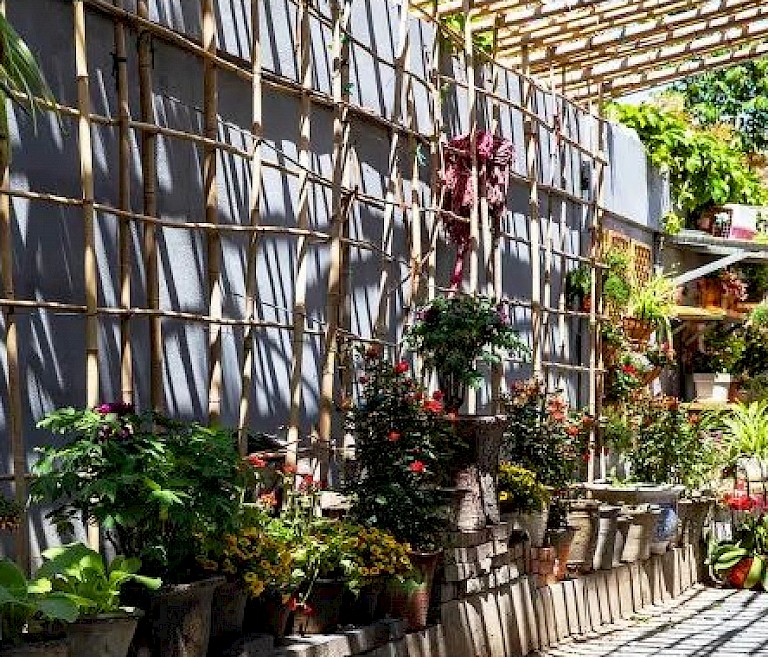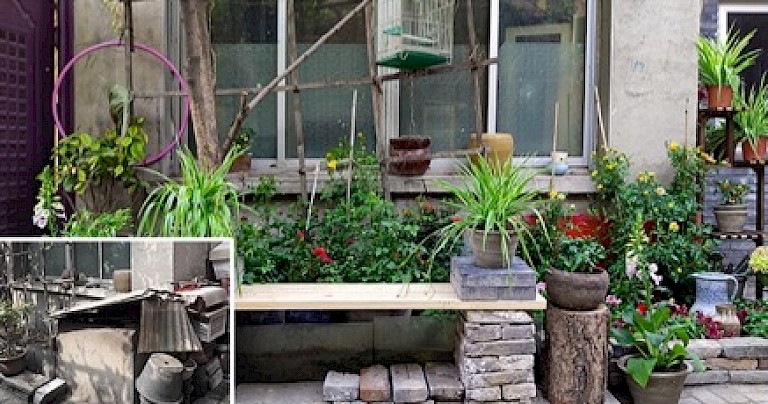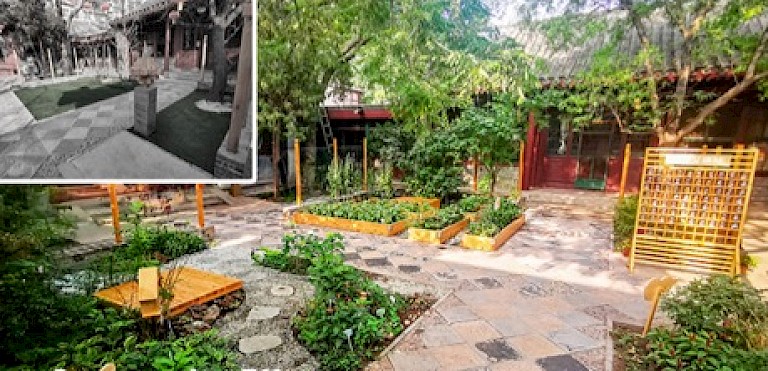



The project explores and forms a sustainable mechanism, with "1+N+∞" as the communication framework, i.e. to create a micro-garden demonstration centre, to radiate and drive the landing of N high-quality micro-garden pilots, to stimulate the public's enthusiasm through public participatory building activities, to empower enthusiastic residents, to drive endless residents and social forces to participate in the construction of micro-gardens, and to explore the paths and modes of spontaneous enhancement of the landscapes of the historically preserved neighbourhoods of the old city of Beijing.
1 Micro-garden Artistic Landscape Demonstration
The unused atrium of ""Hutong No. 71 Courtyard"" will be turned into a ""Micro-garden"" demonstration centre with five Micro-garden ecological samples by tapping community members with planting hobbies in the surrounding residential areas and organising design workshops:
(1) "Healing Ecology" uses plants and landscape installations to mobilise the five senses, allowing people to fully adjust and relax physically and psychologically.
(2) "Edible Ecology" plants edible and ornamental plants to spread the concept of healthy eating.
(3) "Ecology of Old Objects" utilises old objects to create small scenes with a sense of life, demonstrating the aesthetics of micro-garden life in the hutongs.
(4) "Watering Cycle Ecology" utilises spiral gardens to differentiate the water demand of plants and form a sustainable watering system.
(5) "Insect Bio-Ecology" utilises insect hotels and earthworm towers to attract insects and improve local biodiversity.
After the establishment of the demonstration centre, the design team discusses the maintenance mechanism of the Micro-garden with the community residents; studies the adoption system of the Micro-gardens, explores the independent maintenance mechanism of Micro-gardens such as time-sharing, group rotation maintenance, and area adoption with the community management and residents, and helps residents to set up relevant associations such as the "Flower Club", so as to gradually establish the Micro-garden shared governance model.
N Micro-garden Artistic Landscape Pilot: Driven by the micro-garden demonstration centre model rooms, more residents voluntarily signed up to work with designers to remodel and design their own micro-gardens. Residents voluntarily dismantled a coal shed that had been abandoned for more than 20 years and replaced the site it occupied with a planting area through participatory transformation; reused old containers and discarded debris in their homes to plant easy-to-maintain flowers and edible plants; and rationally utilised the air-conditioned water to from the site to form the Micro-garden's automated watering system, gradually building N micro-garden ecosystems and forming a micro-garden network. The project makes ,more residents pay attention to the Micro-gardens, talk about them, and develop them into a socialisation method and a community green renewal mechanism, so that the hutong community will be revitalised with new green vitality.
The construction of N community Micro-gardens drives more residents, government, and social organisations to build Micro-gardens, forming an endless power of participation and establishing a platform for multi-party participation. Form a menu-based Micro-garden construction process by establishing a Micro-garden cloud database, from the location library, design style library, tool library, plant library, and the ecosystem library, residents can choose from the database and use it independently to build Micro-gardens. Release the Research Report on Micro-gardens in Old Beijing, the Practice Manual of Micro-gardens in Old Beijing, and the Map of Micro-gardens, and form online and offline seed communities, planting communities and other Micro-garden communities. Establish online TikTok social accounts, so that more media and magazines will pay attention to the micro-garden, creating endless communication and social impact."
"Beijing Old Town Hutong Community Micro-Garden Series 2015-2023" is a public art intervention in Beijing Old Town Hutong community under the background of Beijing city from incremental expansion to stock renewal, to help the community public space micro renewal and participatory improvement of community governance continuous exploration.
The Project has been continuously updated with the completion of 150+ Micro-gardens, which fundamentally improves the public space environment of hutongs, focuses on the daily life of ordinary people, promotes the exchange and dissemination of residents' green concepts and aesthetics of life, increases the residents' motivation to participate in community governance, and enhances neighbourhood relations and community cohesion. It has helped the city's ecological civilisation construction, social construction and cultural construction.
Significance of the project: Micro-gardens are generally small in area and numerous in number, mostly located in the fragmented Spaces of hutongs and courtyards in old communities. Its upgrading is easy to operate and implement, and can effectively supplement the green space of the city. From an ecological point of view, the Micro-garden takes diversified planting as the carrier and attracts all kinds of insects and micro-organisms at the same time. The rich biodiversity improves the microclimate of hutong communities. From a humanistic point of view, the Micro-garden reflects the old city residents' pursuit of a better life, and is closely connected with the residents' daily living space to reshape the specific residential culture and life aesthetics.
Micro-garden takes small-scale and progressive community micro-renewal as the practice model, which closely links the renewal of ecological environment with the communication between residents and neighbours. Public art is used to help spread communication vitality, culture and art, and lifestyle to achieve sustainable social governance.
1) Effectively alleviate the problem of illegal encroachment on public space. The phenomenon of private debris encroaching on public space is common in the old city, and the green micro renewal of the project can solve the problem to a certain extent. Meanwhile, the project has replaced a number of unauthourized house spaces and space for the accumulation of debris with pleasant micro-garden landscapes through negotiation.
2) Promote the overall environmental quality of the old city centre. The Shijia Hutong Micro-garden Project attracted the attention of Beijing's urban planning and management authorities during its implementation, sending observers to assess its effectiveness of the project and incorporating it into a guidebook for community renewal in Beijing's old cities, with the hope that taking these demonstration sites as a reference, it will lead to more residents participate, gradually realising the overall gradual green micro-renewal of the district.
3) Promote community public art behaviour. Increase the ways for residents to intervene and manage community affairs through the micro-garden program, from design, construction and maintenance, and form relevant norms, which will contribute to the co-construction (social), sharing (have) and co-management (management) of the community's public space.
(4) Explore the way of comprehensive practice of public art in the field of landscape gardening, social governance and other multidisciplinary fields. The Micro-garden Project is a useful attempt for public art to intervene in the renewal of hutong communities in Beijing's old cities, in the context of the city's shift from incremental expansion to stock renewal, redefining the scope of use of public art, and at the same time conducting social management in an artistic way.
"Micro-Garden" is a name card of the green and organic renewal of the old city of Beijing, a representative model of public art helping social governance, providing a new way for residents to participate in community affairs and realise community co-construction, sharing and co-governance. From the participatory planning, design, co-construction and maintenance of micro gardens to the participatory communication of micro gardens, the ultimate goal of micro garden plan is not only to improve the community environment through the transformation of the garden, but also to guide residents to transform the spontaneity of their own environment into the consciousness of participating in community public affairs, so as to promote beneficial communication and communication among residents. To achieve long-term maintenance management. In the current process of renewal of urban stock, the microgarden project offers a possibility derived from life, step by step. Through Micro-gardens, residents can communicate with each other for sustainable communication, better development of public art, and support social governance.


